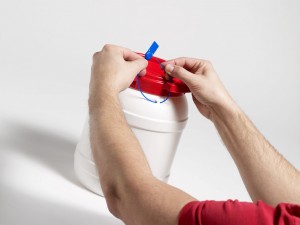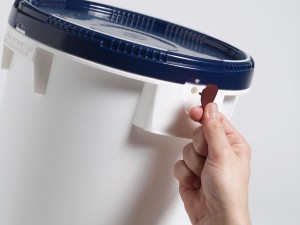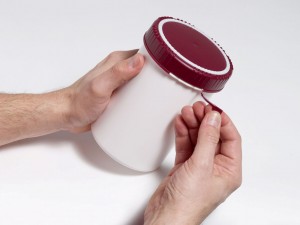By CurTec International
CurTec packaging: ease of use on tamper-evident products
CurTec International’s adaptable pharmaceutical packaging is also designed to support easy tamper-proofing to increases security of product and supply.
CurTec’s range of straightforward pharmaceutical containers also incorporates a range of design features that allow users to make them tamper evident.
This includes aspects like tamper-evident seals easy attachment of barcodes to support track and trace systems to keep your goods safe and secure.
CurTec’s easy to use pharmaceutical drums and containers have screw closure lids that are simple to open or seal, with moisture proof closure and error-free tamper proofing.
Tamper-evident security
As the sophistication and cost of drugs, vaccines and medicines continues to rise, pharmaceutical manufacturers place increasing value on tamper evident packaging to ensure products arrive intact and uncontaminated.
Failure to secure goods against tampering can be life threatening to consumers and undermine the viability of businesses.
The European Consumers’ Organisation estimates that the quantity of counterfeit medicines seized at EU borders has increased by more than 400 per cent over the past five years. Although pharmaceutical manufacturers routinely protect dosed pharmaceuticals using blister packaging or tamper evident containers, the risk of contamination is present throughout the whole supply chain. Tamper evident bulk packaging can be used to ensure protection is given at all times.
Tamper evidence is a sealing that guarantees users that packaging has not been accidentally or deliberately opened during transport or throughout the logistics chain.
Effective primary sealing
An effective packaging seal plays an important primary role in protecting your product’s integrity. CurTec drums and containers have exceptionally effective seals that are proof against air or moisture contamination.
The first level of security is the primary closure where the lid of the container is secured with a band, metal crimped lid, Safe Seal label or shrink sleeve (there may also be a pull tight security seal securing the lid to the body via a loop in each). This level of security attempts to secure the lid so that it cannot accidentally be taken off or even removed to adulterate the contents without this fact being recognized.
The pull tight security seal is a good way of protecting plastic containers of chemicals or pharmaceuticals. Both the lid and body of the container are secured tightly together using a plastic band similar to a cable tie (may also be a steel cable), which cannot be opened without cutting the band. These seals may also incorporate sequential numbering or bar codes for added security during audit or receipt. The Safe Seal label uses a multi-layer technology where the adhesive layer secures the lid to the body of the container and any attempt to remove the label/seal will result in tearing or if attempts are made to ‘peel it off’ a void message being revealed on one of the inner layers.
Tamper-evident inner sealing
The second level of security or closure, which may take the form of an inner ‘foil’ or polymer film adhered to the edge of the container lid, protects material from spillage even if the lid is opened, keeps material sealed under inert atmosphere and so protected from oxidation or degradation and ensures any tampering via this route can be immediately recognized by a broken edge seal.
Some seals may simply use a crimped metal foil moulded over the top of the container without using adhesive. This system has the advantage that no adhesive is used and there is no spring-back of the material when sealing, but the foil could potentially be removed and replaced. However to offer additional protection the foil could be printed with a logo or barcode.
Superior secondary seals include composite laminate foils, peelable blister foils, cold-formable foils or heat-seal coatings. In use the sealing material must be compatible with the material in the container to prevent contamination. In addition, any adhesive must be inert and not contaminate the product. Laminate sealing foils usually have a metal component (aluminium for strength), a barrier component such as EvOH (ethyl vinyl alcohol copolymer), which is impervious to gases and polypropylene for its moisture resistance properties.
Closure foils incorporate a lot more technology than would be seen at first glance. In most cases if a peelable seal is broken then it should be obvious that the container has been tampered with and the contents adulterated – it is not easy to restore a broken seal. In a refinement to this one major German-based converter produces a plain, metallized foil laminated with a holographic embossed silver security foil that has a totally invisible hidden ‘VOID’ message that becomes visible if the label is peeled away indicating it has been opened. Some adhesive seals incorporate a dry peel coating over the adhesive layer that makes it impossible to replace the seal once it has been peeled away.
Multiple Layer Security
No single layer or device is completely ‘tamper-proof’. Therefore multiple ‘layers’ of security may be used in packaging and the multi-system makes counterfeiting or tampering much more difficult.
As well as primary and secondary sealing, the seals or containers themselves may also include barcode or lot numbers printed using laser etching or indelible ink jet printing on them for additional security against counterfeiting or tampering. This means that simple scanning at either end of the supply chain can compare the inventory to the cargo manifest and actual stock to see if the quantities and identity of the containers tally. This is extremely important in the Good Manufacturing Practice (GMP) for pharmaceutical companies as the purity and provenance of all material components needs to be documented prior to incorporation into the manufacturing process.
CurTec drums and containers are designed to accept easy printing of codes and unique numbers on both the container body and lid.
Track and Trace
Pharmaceutical product track and trace is becoming more and more important especially as radio frequency identification (RFID) technology matures and becomes less expensive (RFID chips can now be obtained as stickers or even printed directly on containers using special conductive inks). Track and Trace solutions incorporating RFID, 2D matrix barcodes and DNA codes are used to secure supply chain integrity and to enable suppliers to remotely monitor and protect the integrity of APIs and pharmaceutical products.
Hidden tracking devices that can be moulded into the structure of the container if required can provide continual real time visibility of the product’s progress and integrity. These tracking devices are capable of gathering high accuracy product data including location, temperature, impact, humidity, vibration, pressure and then delivering it to a custom web interface monitored by the manufacturer. Thresholds for each value can be set so that the exact conditions during transport are recorded. If a product encounters sudden drops in pressure or increased temperature then the tracking device will inform the interrogating computer, which can pass on warnings by e-mail or SMS. The system allows the provenance of high value and high risk pharmaceuticals and APIs to be recorded throughout transportation.
Track and Trace options could include several technologies depending upon the level of security required:
- Bar-coded serial number for simple and unique product identification
- Data matrix or two-dimensional (2-D) bar code can encode lot and batch data, product configuration information and even time and place of manufacture.
- RFID based smart labels can hold more data and can even be re-encoded to update the chain of custody for the item
- Electronic Product Code (EPC) RFID technology is the highest level of security with the ability to combine several RFID encoding options with a standardized serial numbering system for unique identification of items. EPC is the leading option for track-and-trace systems in the pharmaceutical industry
CurTec tamper evident packaging
CurTec packaging incorporates tamper evident strips for Drums, Click Pack Y and Lidded Crates.
Click Pack X and Lidded Crates can be closed using CurTec tamper –proof pushpins.
The CurTec Packo small volume container has a tamper evident tear-off strip attached to the lid.
CurTec Drums and Click Pack Y are designed to accept a wide range of tamper evident strips, including the customer’s own personalized TE strips.
The design of the Click Pack container incorporates a large adhesive surface making it easy to use a wide range of third party-supplied sealing foils.
Resources
Click on CurTec packaging: ease of use on tamper-evident products for more information.
Click on CurTec to contact the company directly

CurTec drums can be sealed with any tamper evident strip

Click Pack can be sealed with a special tamper evident pin

Packos have a tamper evident tear-off strip that needs to be removed prior to opening
Supplier Information
Supplier: CurTec International
Address: Spoorlaan Noord 92, P.O. Box 25, 5120 AA Rijen, Netherlands
Tel: +31 88 808 2000
Fax: +31 88 808 2260
Website: www.curtec.com















